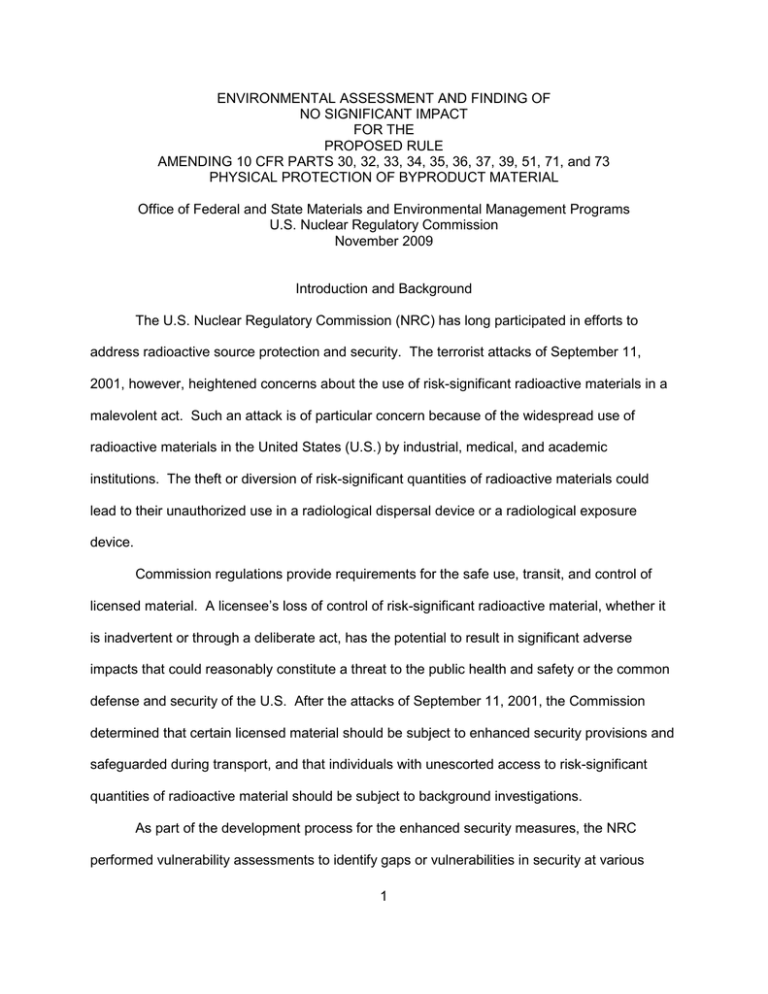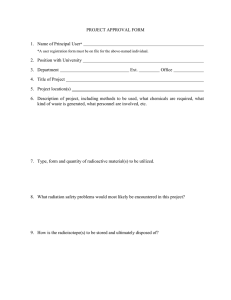ENVIRONMENTAL ASSESSMENT AND FINDING OF NO SIGNIFICANT IMPACT FOR THE PROPOSED RULE
advertisement

ENVIRONMENTAL ASSESSMENT AND FINDING OF NO SIGNIFICANT IMPACT FOR THE PROPOSED RULE AMENDING 10 CFR PARTS 30, 32, 33, 34, 35, 36, 37, 39, 51, 71, and 73 PHYSICAL PROTECTION OF BYPRODUCT MATERIAL Office of Federal and State Materials and Environmental Management Programs U.S. Nuclear Regulatory Commission November 2009 Introduction and Background The U.S. Nuclear Regulatory Commission (NRC) has long participated in efforts to address radioactive source protection and security. The terrorist attacks of September 11, 2001, however, heightened concerns about the use of risk-significant radioactive materials in a malevolent act. Such an attack is of particular concern because of the widespread use of radioactive materials in the United States (U.S.) by industrial, medical, and academic institutions. The theft or diversion of risk-significant quantities of radioactive materials could lead to their unauthorized use in a radiological dispersal device or a radiological exposure device. Commission regulations provide requirements for the safe use, transit, and control of licensed material. A licensee’s loss of control of risk-significant radioactive material, whether it is inadvertent or through a deliberate act, has the potential to result in significant adverse impacts that could reasonably constitute a threat to the public health and safety or the common defense and security of the U.S. After the attacks of September 11, 2001, the Commission determined that certain licensed material should be subject to enhanced security provisions and safeguarded during transport, and that individuals with unescorted access to risk-significant quantities of radioactive material should be subject to background investigations. As part of the development process for the enhanced security measures, the NRC performed vulnerability assessments to identify gaps or vulnerabilities in security at various 1 licensed facilities. The assessments also considered the effectiveness and costs of certain physical protection enhancements. The results of the vulnerability assessments were used in the development of enhanced security orders. The security orders were issued using a graded approach, based on the relative risk and quantity of material possessed by the licensee. The NRC issued the first series of orders to panoramic and underwater irradiator licensees that possessed more than 370 Terabecquerels (10,000 Curies) of radioactive material (EA-02-249; June 6, 2003) (68 FR 35458; June 13, 2003). The next series of orders were issued to manufacturing and distribution (M&D) licensees (EA-03-225; January 12, 2004) (69 FR 5375; February 4, 2004). Subsequently, the NRC issued Increased Control Orders (EA-05-090; November 14, 2005) (70 FR 72128; December 1, 2005) to other licensees authorized to possess certain risk-significant quantities of radioactive material (category 1 and 2 quantities of radioactive material). These security orders specifically addressed the security of byproduct material possessed in quantities greater than, or equal to, category 1 and category 2. The category 1 and category 2 thresholds are based on the International Atomic Energy Agency (IAEA) Code of Conduct1. The orders provide enhanced security measures for license verification before transfer of radioactive material, intrusion detection and response, use of security zones, access control, and coordination with local law enforcement authorities (LLEAs). The orders also contain requirements for the licensee to determine the trustworthiness and reliability of individuals permitted unescorted access to risk-significant radioactive materials. The determination is based upon a background investigation of the individual. During the same time period, efforts were underway to enhance transportation security of category 1 and category 2 quantities of radioactive materials. The first set of transportation 1 International Atomic Energy Agency Code of Conduct on the Safety and Security of Radioactive Sources, IAEA, Vienna, 2004. 2 security orders was issued to licensees that might be expected to transport radioactive materials in quantities of concern (category 1 quantities) (EA-05-006; July 19, 2005) (70 FR 44407; August 2, 2005). Subsequently, the NRC issued orders (EA-05-090; November 14, 2005) (70 FR 72128; December 1, 2005) to other licensees authorized to possess category 1 and category 2 quantities of radioactive material. These Increased Control Orders mentioned above also contain requirements for transporting category 2 quantities of radioactive material. These security orders specifically address the transportation security of byproduct material in quantities greater than, or equal to, category 1 and category 2. These additional security measures provide for enhanced security during transportation beyond the current regulations, including enhanced security in preplanning and coordinating shipments, advance notification of shipments to the NRC and States through which the shipment will pass, control and monitoring of shipments that are underway, trustworthiness and reliability of personnel, information security considerations, and control of mobile or portable devices. In 2005, Congress passed, and the President signed, the Energy Policy Act of 2005 (EPAct). The EPAct amended Section 149 of the Atomic Energy Act (AEA) to authorize the Commission to require to be fingerprinted any individual who is permitted unescorted access to radioactive material or other property subject to regulation by the Commission that the Commission determines to be of such significance to the public health and safety or the common defense and security as to warrant fingerprinting and background checks. With this new authority, the Commission determined that individuals who have access to category 1 and category 2 quantities of radioactive material warrant fingerprinting and background checks. Reviewing an individual’s fingerprint-based Federal Bureau of Investigation (FBI) criminal history records check is one of the important elements of the background check. This review can provide comprehensive information regarding an individual’s recorded criminal activities within the U.S. and its territories and the individual’s known affiliations with violent gangs or 3 terrorist activities. On October 17, 2006, the NRC issued orders to panoramic and underwater irradiator licensees (EA-06-248) (71 FR 63043; October 27, 2006), M&D licensees (EA-06-250) (71 FR 53046; October 27, 2006), and licensees making shipments of category 1 quantities of radioactive material (EA-06-249) (71 FR 62302; October 24, 2006) to require fingerprinting and FBI criminal history records checks for unescorted access to risk-significant quantities of radioactive material at their facilities. On December 5, 2007, the NRC issued orders to all other NRC licensees that possessed category 1 or category 2 quantities of radioactive material (EA07-305) (72 FR 70901; December 13, 2007) to require fingerprinting and FBI criminal history checks for unescorted access to category 1 or category 2 quantities of radioactive material. Proposed Action The NRC is proposing to amend its regulations to create a new Part 37 and make conforming amendments to other NRC regulations to incorporate effective security measures for the protection of category 1 and category 2 quantities of radioactive material into the NRC’s regulations. The NRC considers category 1 and category 2 quantities of radioactive material to be risk significant and, as such, believes that these materials warrant additional protection. The objective of this proposed rule is to provide reasonable assurance of preventing the theft or diversion of category 1 and category 2 quantities of radioactive material. New requirements for background investigations and an access authorization program are proposed to ensure that individuals who have access to these materials have gone through background investigations and are determined to be trustworthy and reliable. New requirements are also proposed to establish physical protection systems to detect, assess, and respond to unauthorized access to category 1 and category 2 quantities of radioactive material. For transport of the radioactive materials, new requirements for recipient license verification; 4 preplanning and coordination of shipments; advance notification of shipments; notification of shipment delays, schedule changes, and suspected loss of a shipment; and control and monitoring of shipments are proposed. The proposed amendments would also include security requirements for shipments of irradiated reactor fuel that have a net weight of 100 grams or less of irradiated fuel, exclusive of cladding or other structural or packaging material. The proposed action would neither authorize nor license the use of any radioactive materials; licensees and applicants would still need to comply with the NRC’s licensing requirements before obtaining radioactive materials. The proposed amendments would impact any licensee that is authorized to possess category 1 or category 2 quantities of radioactive material. Approximately 1, 400 NRC and Agreement State licensees would be impacted. Need for the Proposed Action The requirements put in place by the orders supplement existing regulatory requirements. These additional requirements are primarily intended to provide reasonable assurance of preventing the theft or diversion of this risk-significant material. The orders provide the Commission with reasonable assurance that the public health and safety and the common defense and security are adequately protected given the current threat environment. Evaluating the basis for these orders and adopting the security requirements in a rule allows the NRC to impose these requirements on all current and future licensees without future regulatory action. Further, notice and comment rulemaking is an open process that allows for public participation. Although these security requirements could continue to be imposed by orders, the existing regulations do not reflect current Commission policy or requirements. Amending the regulations allows the Commission to revise the security requirements in the orders and to 5 incorporate these requirements into the regulations where they apply to all current and future NRC licensees. Environmental Impact This environmental assessment focuses on those aspects of the byproduct material security rulemaking where there is a potential for the requirements to affect the environment. This proposed action would impose new or modified security requirements on a number of the NRC’s licensees, but in no case would this proposed amendment authorize the possession or use of radioactive material. Licensees would still be subject to the licensing requirements in the rest of the NRC’s regulations. The NRC has concluded that there will be no significant radiological environmental impacts associated with implementation of the security rule requirements. The security requirements would not result in changes to the systems in affected licensees’ facilities that function to limit the release of radiological effluents. All systems associated with limiting the releases of offsite radiological effluents will therefore continue to be able to perform their functions, and as a result, there are no significant radiological effluent impacts. The standards and requirements applicable to radiological releases and effluents are not affected by the security rulemaking and continue to apply. The principal effect of this action is to revise the governing regulations pertaining to byproduct material security and to make generically applicable security requirements similar to those previously imposed by the enhanced security orders. None of the revisions affect current occupational exposure requirements; consequently, the NRC has concluded that this action has no impact on occupational exposure. 6 The proposed action does not significantly increase the probability or consequences of accidents, nor result in changes being made in the types of any effluents that may be released offsite, and there is no significant increase in occupational or public radiation exposure. With regard to potential nonradiological impacts, implementation of the rule requirements does not have a significant impact on the environment. Facility footprints should not change due to the proposed action. No construction of new structures is required to meet the requirement in the proposed rule. While the requirements of this rule could result in some licensees making modifications to their existing facilities, the NRC does not anticipate such modifications to have any significant environmental impact. In addition, the requirements do not affect any historic site and do not affect nonradiological plant effluents. Consequently, there are no significant non-radiological plant effluents. Therefore, there is no significant non-radiological environmental impact associated with this rule. Accordingly, the NRC concludes that there is no significant environmental impact associated with the rulemaking action. Alternatives to the Proposed Action As an alternative to the proposed action, the NRC staff considered not taking the action (i.e., the no-action alternative). Not revising the security regulations results in no change in current environmental impacts since the requirements would result in no significant environmental impact. Therefore, taking no action results in no net change to the environmental impact. However, the no-action alternative would leave the existing security requirements in tact, and as such, the NRC’s security requirements for category 1 and category 2 quantities of radioactive material would not reflect the requirements that the NRC has concluded are necessary for the 7 adequate protection of the public health and safety and the common defense and security. The no action alternative would require the NRC to issue security orders to any future licensees. The NRC staff also considered a rulemaking that would require all licensees that are authorized to possess category 1 or category 2 quantities of radioactive material to implement the security measures instead only those licensees that possess the material as would be required by the proposed rule. This alternative would impact about 2,950 licensees. The actual security requirements would be similar and would have similar environmental impacts. From an environmental standpoint, neither rulemaking option is obviously superior to the other. The NRC has chosen the proposed action because it most closely matches the rulemaking objectives. Alternative Use of Resources There are no irreversible commitments of resources determined in this assessment. Agencies and Persons Consulted No agencies or persons outside the NRC were contacted in connection with the preparation of this draft environmental assessment. The NRC has sent a copy of the draft environmental assessment and the proposed rule to every State Liaison Officer and requested their comments on the environmental assessment. Finding of No Significant Impact Under the National Environmental Policy Act of 1969, as amended, and the NRC 8 regulations in subpart A of 10 CFR part 51, the NRC has determined that this proposed rule, if adopted, would not be a major Federal action significantly affecting the quality of the human environment and, therefore, an environmental impact statement is not required for this rulemaking. The proposed amendments are procedural in nature and would have no significant impact on the environment. The determination of this environmental assessment is that there will be no significant impact to the public from this action. However, the general public should note that the NRC welcomes public participation. Comments on any aspect of the environmental assessment may be submitted to: Secretary, U.S. Nuclear Regulatory Commission, Washington, DC 205550001, Attn: Rulemakings and Adjudications Staff. 9




